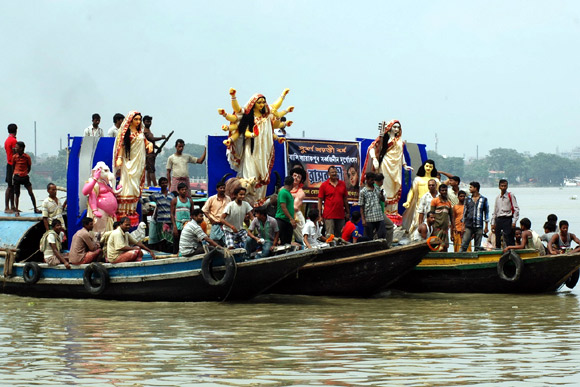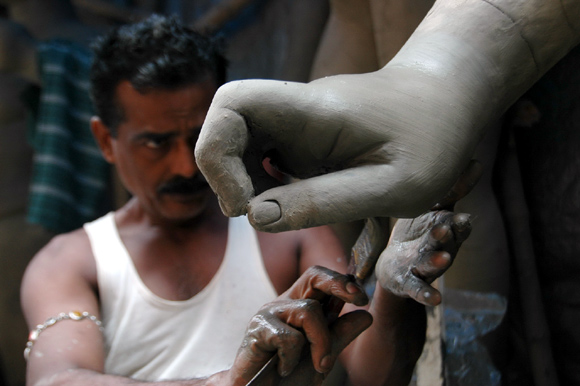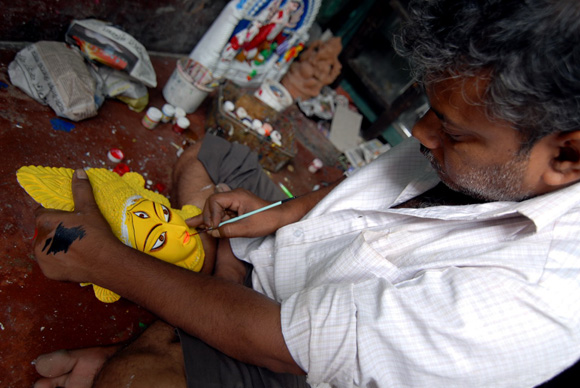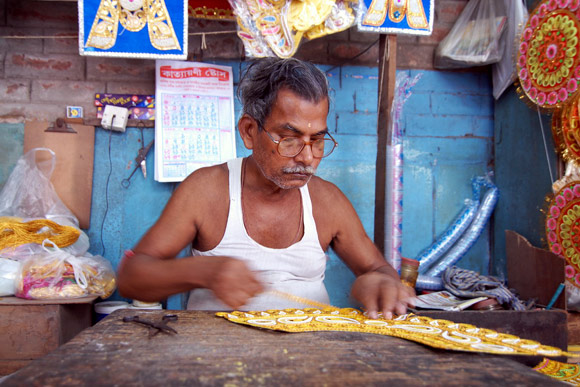Photographs: Dipak Chakraborty Indrani Roy in Kolkata
Rediff.com's Indrani Roy takes a walk through the dingy by lanes of Kumortuli in Kolkata and interacts with artisans who add final touches to Durga idols.
Durga Puja is just round the corner.
As we gear up to celebrate the festival of festivals, we must not forget the tireless toil of potuas (artisans) of Kumortuli, potters' village.
Months before the Puja, Kumortuli's unassuming, dingy lanes transform into makeshift dwelling places for hundreds associated with the idol making industry, a thriving business.
To catch the artisans adding final touches to their creations and to share their experiences, we visited the muddy contours of Kumortuli on Tuesday.
In this slide show, we take you on a tour of the place where gods are made.
Even before one enters Kumortuli, an intoxicating smell of wet clay fills one's senses -- a smell that reminds one of the untimely shower.
At the moment, this seat of about 350 kumors (potters) is buzzing with activity.
Click NEXT to see more PHOTOS...
A bit of history
Image: A Durga idol being carried by pottersPhotographs: Dipak Chakraborty
During the reign of British East India Company, separate districts were allotted to the company's workmen.
These neighbourhoods were named after the residents' means of livelihood -- suripara (residency of wine sellers), Collutolla (residency of oil sellers), Chuttarpara (residency of carpenters), Aheeritolla (cowherd's quarters), Kumortolla (potters' quarters) and so on.
Most of these people dwindled in numbers in the late nineteenth century. The potters of Kumortolla or Kumortuli somehow managed to survive. Gradually they took to making the images of gods and goddesses, worshipped in the mansions in and around Kolkata.
It is said that in the past, potuas collected dust from brothels of Sonagachi, a red light area in north Kolkata, and mixed it with the clay used for making the idols.
That tradition, though mostly on its way out, is followed by organisers of some old puja committees of Bengal.
Click NEXT to see more PHOTOS...
The Puja that was
Image: A Durga idol is ferried across the Ganga by members of Bali Sarbojonin Durgotsav CommitteePhotographs: Dipak Chakraborty
In an article in The Telegraph, 1944: the year that was, ace writer of Bengal Sunil Gangopadhyay recalled:
'In those days, instead of buying the idols from the market at Kumortuli, families invited the kumor or artisan home to stay as a house guest weeks before the Puja, during which time he sculpted the idol.
The idol at our Puja was known for its magnificent size. It used to be over 10 foot tall.
Every morning as the kumor started his work, we children gathered around him and gaped in awe as he gradually turned a fistful of straw and a huge mass of clay into a perfectly formed, larger-than-life figure.
And then came the most intriguing part -- the painting of the third eye of the Goddess. The artisan would sit in meditation sometimes for hours and then suddenly in one swift stroke of his paint brush, it would be done.'
Click NEXT to see more PHOTOS...
Making of the idol
Image: An artisan at work in KumortuliPhotographs: Dipak Chakraborty
Making of Durga idols is a backbreaking process, Mohan Pal, one of the artisans of Kumortuli told rediff.com.
"The skeleton structure of bamboo and straw is created by one group while the clay mixing and its applications are done by another.
Finally, the head, palms and feet are done by the senior most artisans.
Once the structure is made, layers of clay are applied to it.
This is done in three steps.
The straw figurine of goddess gets the first coat of watery clay.
This application helps to fill the crevices left by the straw.
The second layer is less watery and it gives prominence to the figure.
Palms, head and feet, which are separately made, are attached with the torso at this stage.
Click NEXT to see more PHOTOS...
Heads are done by the most experienced hands
Image: Heads of the idols are generally done by the Pals, most experienced lot.Photographs: Dipak Chakraborty
After this, pieces of cloth soaked in fine clay are used to do up the joints which develop cracks after drying.
Once the clay structure is complete, the figure is painted with white earth colour followed by coats of pink or yellow.
The eyes are then painted and other detailing done by the leading artist of the team. The idols of Durga are then varnished.
Hair made of jute is glued and the idol is dressed and ornamented.
"On an average, four to five people directly work on each idol, whereas about 250 people, mostly residents of southern suburbs of Kolkata, are indirectly involved in the process," Pal informed rediff.com.
Each team, consisting of five people on an average, in Kumortuli earns about Rs 30,000 per Puja and each artist gets an order for 10 to 12 idols.
Once finished, the idols meant for export are plastic-coated and packed by reputed packers before being shipped out.
There are dealers in Kumortuli who sell ornaments and other accessories used for decorating the idols.
"At times, buyers opt for a fully-decorated idol while in some cases, the decoration is done at the pandals," Pal said.
Click NEXT to see more PHOTOS...
How costly are the idols?
Image: A worker makes ornaments that adorn the Goddess.Photographs: Dipak Chakraborty
The cost of an idol varies according to its size.
For example, a four to five-foot idol weighing 50-60 kilogram is expected to fetch Rs 6,000 to Rs 15,000, whereas a taller version, a 20-foot structure, can fetch as much as Rs 30,000 to Rs 35,000, said Pal.
Idols that are exported have to be packed meticulously.
After packing, a 55-60 kilogram idol weighs about 200-250 kilogram.
In the last couple of years, export of idols had taken a hit because of global recession.
However, things are looking up this year.
According to reports, in 2011, 38 idols were exported fetching Rs 48 lakhs (Rs 4.8 million) whereas this year, 44 idols have been shipped bringing Rs 55 lakhs (Rs 5.5 million) for the potuas of Kumortuli.
Idols for export are either sent by ship or by air through different courier companies.
It takes an idol about 45 days to reach USA by ship.
Though transfer by air is quick and less hazardous, it is very costly.
Click NEXT to see more PHOTOS...
Paper-pulp idols are the best for low-budget Pujas
Photographs: Dipak Chakraborty
As far as domestic and overseas markets are concerned, demand is high for idols made of thermocol, glass fibre (these idols are the costliest, worth over Rs 1,50,000 each), and those made of plywood.
Idols are exported months before the festival from artisans' studios in Kumortuli to USA, the United Kingdom, South Africa, Ethiopia, Australia, New Zealand, Sri Lanka, Mauritius, Fiji, Philippines.
"For the first time this year, Ma travelled to Barcelona, Spain", said Pal.
Organisers of low-budget pujas often opt for paper-pulp idols.
Click NEXT to see more PHOTOS...
Now, potuas go online
Image: A man selling weapons that the Goddess carries.Photographs: Dipak Chakraborty
In keeping with the modern times, some of the artisans of Kumortuli have launched websites to interact with customers, domestic as well as overseas.
The website http://www.kumartuli.com is a case in point run by Shilpa Bharati.
"This website helps us to get in touch with our clients directly," Prodyut Pal, who looks after Shilpa Bharati's marketing told rediff.com.
The year 2012 has been good for Pal and his company as they exported as many as five fibre-glass idols to USA (a huge structure measuring 11foot by 22 foot), Canada (10 foot), Mauritius (5-6 foot) and UK (5 foot).
Over and above this, Pal's company got orders from numerous puja organisers across Bengal.
"Big orders not only mean big money. They also mean that people are appreciating our work. It's a great satisfaction for an artist," Pal said.
"Though we were hit by economic drought in the last few years, business is much better this time," he said.
"We hope financial pundits come up with great plans to counter the financial crisis across the globe. While that would help us improve the state of potuas like us, it will also bring foreign exchange for the country."
TOP photo features of the week
...









article